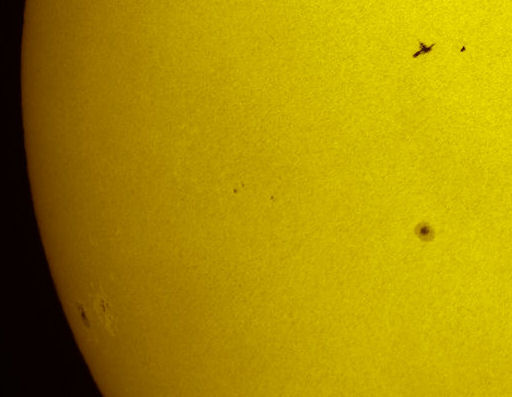They came from outer space--and you can have one! Genuine meteorites are now on sale in the Space Weather Store. | | |
PLUTO'S NEW MOON: Astronomers using the Hubble Space Telescope have discovered a fourth moon orbiting Pluto. The new satellite popped up in a Hubble survey searching for rings around the dwarf planet. Science@NASA has the full story.
NOTE TO ASTRONAUTS: Be alert for auroras. As the hours wind down on the final mission of NASA's 30-year shuttle program, a solar wind stream is buffeting Earth's magnetic field, prompting NOAA forecasters to declare a 30% chance of high-latitude geomagnetic activity during the next 24 hours. Pausing to look out the window of Atlantis could be a rewarding experience.
SPACESHIPS IN THE SUN: Space shuttle Atlantis undocked and backed away from the International Space Station on July 19th at 4:18 am EDT. Less than an hour later, the two spacecraft flew directly in front of the sun over the Czech Republic in Europe:

Astrophotographer Thierry Legault traveled 1300 km from Paris to take the picture--the last double transit of the shuttle program. "The shuttle was poised to begin its flyaround of the ISS at the time of the transit," he says. Legault has taken pictures like this before, sometimes even better, but never quite so final. The shuttle will return to Earth permanently on Thursday, July 21st, at 5:57 am EDT. "Farewell, Atlantis!" says Legault.
more images: from Martin Gembec of Albrechtice, Czech Republic
HOT DINNER: Paleontologist and amateur astronomer Wienie van der Oord lives in the Arava desert in Israel, close to the Jordanian and Egyptian border. "A friend and I were hiking in the area before sunset on July 16th when I realized we hadn't eaten since breakfast," says van der Oord. It was time for a hot dinner:

"Anna tried to prevent me from burning my mouth as I took a bite out of the sun," continues van der Oord. "The meal was not as filling as I expected, so later I had the Moon for desert."
Other photographers are also finding the sun to be an appetizing target. Click on the links for more snapshots: from Tom of Derby, Western Australia; from Matthias Juergens of Gnevsdorf, Germany; from Peter Desypris of Island of Syros, Greece; from Michael Borman of Evansville, Indiana;
2011 Noctilucent Cloud Gallery
[previous years: 2003, 2004, 2005, 2006, 2007, 2008, 2009]
June 2011 Aurora Gallery
[Aurora alerts: text, voice] [previous Junes: 2010, 2008, 2001]

